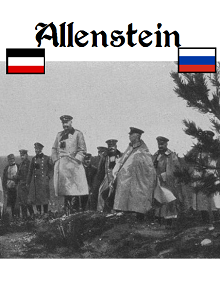Irrational Number Line Games, LLC
home stuff-to-buy idea archive about-us contact
 So, I wrote up a quick scenario about (what I think is) an interesting
battle with a couple of unque aspects - Tannenberg (1914). The battle
of Tannenberg took place at the opening of WWI. A grossly outnumbered
and unsupported German force routed a much larger Russian invading
force and stalled the need to fight a two-front war.
So, I wrote up a quick scenario about (what I think is) an interesting
battle with a couple of unque aspects - Tannenberg (1914). The battle
of Tannenberg took place at the opening of WWI. A grossly outnumbered
and unsupported German force routed a much larger Russian invading
force and stalled the need to fight a two-front war.
The German Eigth Army in East Prussia at the outset of the war was a token force. The strategy was win in the east, the concentrate on the east. Well, the Russians weren't quite so obliging. They brought two armies, numbering about 250K each to bear on the German force of about 150K.
Despite this disadvantage, the Germans had a couple of things going for them:
- Home Turf. Or, more specifically, the Russian trains were a different rail gauge, so when they crossed the border into East Prussia, they took on a huge mobility and logistics handicap. On the flip side, the Germans could still pretty much load and and move at will.
- Animosity. The two Russian commanders didn't like each other. I mean they really didn't like each other to the point of not supporting each other and allowing the Germans to fight them one at a time. After Rennenkapf sent the Germans back in his initial engagement, he just hung around in the area taking care of his own troops while Samsonov fought on his own.
- Intelligence. The intercept-the-other-guys-plans kind (though with Hindenberg at the helm and the Russians playing "no, you fight them", the Germans had the other kind, too). Along with loosing rail transport, the Russians also lost secure telegraph communications at the border. Instead, they fell back to communicating orders over radio, without encryption. The Germans heard, translated, and took advantage.
 So, for
this scenario, we are just going to fight the
Second Army (Samsonov) - Eight Army (Hindenberg) part. The set up in the
.pdf gives a few simple rules and a basic force laydown to play the game
at a high level in a few hours and get the feel for how the German advantages
(as I have framed them) play out.
So, for
this scenario, we are just going to fight the
Second Army (Samsonov) - Eight Army (Hindenberg) part. The set up in the
.pdf gives a few simple rules and a basic force laydown to play the game
at a high level in a few hours and get the feel for how the German advantages
(as I have framed them) play out.
This is certainly not a definitive historical treatise on the battle. But it allows you to play some important parts and get the feel for them without getting bogged down in exactly what color the 1st Lithuanian Dragoons boots were. This is part of why I called the scenario "Allenstein" instead of the historical name (chosen for a political reason), to keep some distance between this bit that I find intriguing and the battle as a historical event (which if I find intriguing in different ways, as well).
Another advantage of this approach is that you can fairly easily substitute in troops from another genre and still play this battle, in a way. The intel piece works well in a lot of other milieux. It's not a bad way to play some "real" magic (as opposed to tactical magic that is nothing more than technology in disgusie) in a fantasy campaign. One side has a scryer, the other doesn't.
An important aspect of the stats (for choosing other forces from other systems) is that the QILS dice do a good job of capturing that late 19th Century-early 20th Century transition into the dominance of range over ... well ... pretty much everything else. There is still a place for charges and melee in this scenario, as there was in the battle itself.
One thing I am pondering getting around to is a big "what-if" departure from what happened and have the Germans fight both armies. Except the Russians are competing for kills making this a three sided battle instead of a two sided battle. So the Russians can't win ... only Samsonov or Rennenkampf. For this, I would start the Russian armies (Rennenkampf gets the same army composition) in the northeast and southeast corners of the board. I would also bring in reinforcements for Hindenberg at a random spot. Maybe shuffle the ace (one) through ten of spades, turn over a card each round, and when the total is more than twenty (3-6 rounds), give the Germans a force equal to their starter at the west border of the map. Victory would be total units killed, so the Russians are going to have to actively interfere (but no Russian on Russian attacks - that would run against the "honor duel" between R and S) with each other to win, and the Germans could still win by taking out more units that either Russian commander (not both). That would work well with orcs!